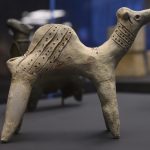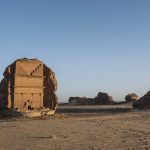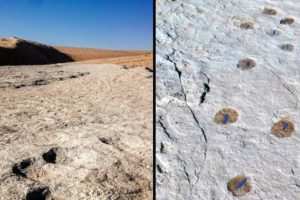
Ancient Tomb Built to Flood—Sheds Light on Peru Water Cult?
Archaeologists in Peru thought they had discovered something special when they uncovered the tomb of a pre-Inca priestess and eight other corpses in 2011. But an even bigger find was right beneath their feet.
Continuing their search for artifacts a year later, the team dug beneath the priestess, uncovering a basement tomb they believe was built by an ancient water cult and meant to flood.
“This is a very valuable finding,” said Carlos Wester La Torre, head of the excavation and director of the Brüning National Archaeological Museum in the Lambayeque region—a region named after the little-known culture that built the stacked tomb. “The amount of information of this funerary complex is very important, because it changes [what we know of] the political and religious structures of the Andean region.”
The nearly 800-year-old basement burial sheds light on complex Lambayeque social structures and on the worship of water in the culture.
Four sets of waterlogged human remains were found in the flooded tomb, one adorned with pearl and shell beads—indicators of wealth or status. The other three corpses likely were intended to accompany the body into the next world.
The faces of both elite individuals, in the lower and upper tombs, were covered with copper sheets, and wore earspools bearing similar, wavelike designs.
While other saturated burial sites have been discovered in the region, this is the first documented discovery of a stacked grave holding revered people, according to archaeologist Izumi Shimada, a Lambayeque expert at Southern Illinois University who was not part of the excavation team.
A diagram shows a recently unearthed stacked grave of Lambayeque elites. The priestess on the first floor was found seated, while bodies on the bottom floor were found lying down, below the water table (marked by a dotted line).
Image courtesy Carlos Wester La Torre, Brüning National Archaeological Museum
Water Worship
The Lambayeque, sometimes called the Sicán, had carved out a home along the drought-prone Peruvian coast nearly a hundred years before the Inca arrived.
The stacked tomb sits in a sprawling ceremonial complex called Chotuna-Chornancap, close to the modern city of Chiclayo (map). The spiritual center’s coastal location, water-themed art, and recently discovered grave may help round out the creation story of the Lambayeque.
According to folklore, their mythical founder, Naymlap, arrived on a raft from the sea and walked on crushed Spondylus shells—a ritual item treasured throughout the Andes. When he died he turned into a bird. (See “Pictures: ‘Mythical’ Temple Found in Peru.”)
“These concepts—birds and water—are part of their beliefs and help them understand life and death,” dig leader Wester La Torre said.
The watery grave contained piles of shells and wave-embossed gold earspools—more evidence of the importance of water to the Lambayeque.
They knew the tomb—located below the water table, where the ground is always saturated—would flood, Wester La Torre said. They likely wanted it to flood, he added, perhaps to ensure the region’s agricultural fertility.
This Lambayeque, after all, thrived for nearly 600 years—from A.D. 800 to 1375—in a mercurial environment. To grow food in the desert, they built complex and extensive irrigation systems. And rare periods of torrential rain could wreak nearly as much havoc as the persistent aridity.
The practice of a groundwater burial could also link the Lambayeque to that later Andean culture, the Inca, Wester La Torre said. “The Inca believed that the dead became a seed, which sprouted new life,” he explained. “The way that this person was buried suggests the same process of fertilization, in which the seed, the person, is reborn.”
(Read more on Wester La Torre’s work: “Pictures: Human-Sacrifice Chamber Discovered in Peru.”)
Stacked Burial
Nearly a year ago, Wester La Torre discovered the first tomb 16 feet (5 meters) underground. While digging deeper for artifacts, his team found the lower tomb under the water table, at that time just 20 feet (6 meters) below the surface.
Stacked burials are highly unusual in Andean archaeology, according to Wester La Torre and Shimada. Typically elite tombs are found in isolation.
(Pictures: “New Pyramid Found With Vivid Murals, Stacked Tombs.”)
While archaeologists have not yet determined the sex of the person in the flooded tomb, Wester La Torre said the individual may have been related to the important woman overhead. Alternatively, the two may have shared a religious, commercial, or political relationship, such as a succession of power.
Changing Tides
While Wester La Torre is confident that the Lambayeque intentionally placed the grave in groundwater, other archaeologists question whether the tomb actually flooded during Lambayeque times. The area water table, they note, fluctuates with rainfall and irrigation levels.
Some archaeologists say modern agriculture may have raised the water table, meaning the original grave would have been dry. The more cropland farmers irrigate, the more run-off they see percolating into the soil and underground reservoirs.
“What we don’t really know is the water table 800 years ago,” says Southern Illinois University’s Shimada. “We don’t know where it was.”
Regardless of water levels, Shimada said, “the single most important aspect of this superimposed tomb is that both [burials] date to a time period that is still not well known. It is one of the very few elite tombs dating to the Late Sicán.”
Having reached the height of their power, the Sicán were buffeted by a drought and huge flood roughly around A.D. 1100.
The disasters launched the culture into a “period of chaos and decline,” Shimada said. The capital moved to a new location, and the civilization entered its late period.
Although the Lambayeque’s territory shrank, their society remained a power in the region, archaeologists say—and the new tomb discovery appears to back them up.
“The tomb suggests that, indeed, shortly after the series of natural disasters … ,” Shimada said, “they maintained a great deal of wealth.”
Alia Isabel Puig translated Carlos Wester La Torre’s interview.
Victoria Markovitz
for National Geographic News
Published September 6, 2012















Add Comment